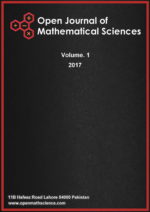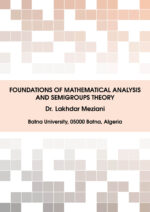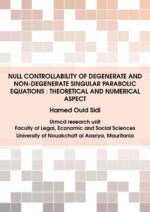Ptolemy Scientific Research Press (PSR Press)is a highly regarded publisher of scientific literature dedicated to bringing the latest research and findings to a broader audience. With a focus on cutting-edge research and technology, Ptolemy Scientific Research Press offers a range of publications catering to professionals, researchers, and student’s needs. Whether looking for information on the latest breakthroughs in physics, biology, engineering, or computer science, you can trust Ptolemy Scientific Research Press to deliver insightful, accurate, and engaging content. With its commitment to quality, accessibility, and innovation, Ptolemy Scientific Research Press is an essential resource for anyone interested in science and technology.

Latest Published Articles
OMS-Vol. 3 (2019), Issue 3, pp. 217 – 233 Open Access Full-Text PDF
Nicholas Kwasi-Do Ohene Opoku, Farai Nyabadza, Ethel Ngarakana-Gwasira
Abstract: Cervical cancer is a global threat with over half a million cases worldwide and over 200000 deaths annually. Sexual minority women are at risk for infection with human papillomavirus (HPV); the virus which causes cervical cancer, yet little is known about the prevalence of HPV infection. In this paper, the dynamics of HPV infection in the presence of vaccination among women which progresses to cervical cancer is investigated. The disease-free equilibrium state of the model is determined. Using the next generation method, the cancer reproduction number, \(R_0\), is computed in terms of the model parameters and used as a threshold value. The reproduction number is examined analytically for its sensitivity to the vaccination parameter having shown that it is locally and globally asymptotically stable for \(R_0<1\) and unstable for \(R_0>1\) at the disease free state. The centre manifold theorem is used to determine the stability of the endemic equilibrium and shown to exhibit a backward bifurcation phenomenon implying that cervical cancer due to HPV infection may persist in the population even if \(R_0<1\). Finally, numerical simulations are carried out to obtain analytical results. As prevalence estimates vary between sexual orientation dimensions, these findings help inform targeted HPV and cervical cancer prevention efforts.
Existence of an integral operator and its consequences in fractional and conformable integrals
OMS-Vol. 3 (2019), Issue 3, pp. 210 – 216 Open Access Full-Text PDF
Ghulam Farid
Abstract: The study of integral operators has always been important in the subjects of mathematics, physics, and in diverse areas of applied sciences. It has been challenging to discover and formulate new types of integral operators. The aim of this paper is to study and formulate an integral operator of a general nature. Under some suitable conditions the existence of a new integral operator is established. The boundedness of left and right sided integral operators is obtained and further boundedness of their sum is given. The investigated integral operators derive several known integrals and have interesting consequences for fractional calculus integral operators and conformable integrals. The presented results provide the boundedness of various fractional and conformable integral operators simultaneously.
On the oscillation of fractional differential equations via \(\psi\)-Hilfer fractional derivative
EASL-Vol. 2 (2019), Issue 3, pp. 1 – 6 Open Access Full-Text PDF
Devaraj Vivek, Elsayed M. Elsayed, Kuppusamy Kanagarajan
Abstract: In this paper, we study the oscillatory theory for fractional differential equations (FDEs) via \(\psi\)-Hilfer fractional derivative. Sufficient conditions are established for the oscillation of solutions FDEs.
On edge-prime cubic graphs with small components
ODAM-Vol. 2 (2019), Issue 2, pp. 48 – 58 Open Access Full-Text PDF
Gee-Choon Lau, Sin-Min Lee, Wai Chee Shiu
Abstract: Let \(G= G(V,E)\) be a \((p,q)\)-graph. A bijection \(f: E\to\{1,2,3,\ldots,q \}\) is called an edge-prime labeling if for each edge \(uv\) in \(E\), we have \(GCD(f^+(u),f^+(v))=1\) where \(f^+(u) = \sum_{uw\in E} f(uw)\). A graph that admits an edge-prime labeling is called an edge-prime graph. In this paper we obtained some sufficient conditions for graphs with regular component(s) to admit or not admit an edge-prime labeling. Consequently, we proved that if \(G\) is a cubic graph with every component is of order \(4, 6\) or \(8\), then \(G\) is edge-prime if and only if \(G\not\cong K_4\) or \(nK(3,3)\), \(n\equiv2,3\pmod{4}\). We conjectured that a connected cubic graph \(G\) is not edge-prime if and only if \(G\cong K_4\).
Some properties of the solutions of the difference equation \(x_{n+1}=a x_{n}+\dfrac{b x_{n} x_{n-4}}{c x_{n-3}+dx_{n-4}}\)
ODAM-Vol. 2 (2019), Issue 2, pp. 31 – 47 Open Access Full-Text PDF
Abdualrazaq Sanbo, Elsayed M. Elsayed
Abstract: In this article, we study some properties of the solutions of the following difference equation: \(x_{n+1}=a x_{n}+\dfrac{b x_{n} x_{n-4}}{cx_{n-3}+dx_{n-4}},\quad n=0,1,…\) where the initial conditions \(x_{-4},x_{-3}, x_{-2}, x_{-1}, x_0\) are arbitrary positive real numbers and \(a, b, c, d\) are positive constants. Also, we give specific form of the solutions of four special cases of this equation.
Transmission dynamics of two strain herpes simplex virus
OMS-Vol. 3 (2019), Issue 1, pp. 198 – 209 Open Access Full-Text PDF
Shamsuddeen Ibrahim, Nicholas Kwasi-Do Ohene Opoku, Hamenyimana Emanuel Gervas
Abstract: A deterministic model for the transmission dynamics of two-strains Herpes Simplex Virus (HSV) is developed and analyzed. Following the qualitative analysis of the model, reveals a globally asymptotically stable disease free equilibrium whenever a certain epidemiological threshold known as the reproduction number (\(\mathcal{R}_0\)), is less than unity and the disease persist in the population whenever this threshold exceed unity. However, it was shown that the endemic equilibrium is globally asymptotically stable for a special case. Numerical simulation of the model reveals that whenever \(\mathcal{R}_1<1<\mathcal{R}_2\), strain 2 drives strain 1 to extinction (competitive exclusion) but when \(\mathcal{R}_2<1<\mathcal{R}_1\), strain 1 does not drive strain 2 to extinction. Finally, it was shown numerically that super-infection increases the spread of HSV-2 in the model.








